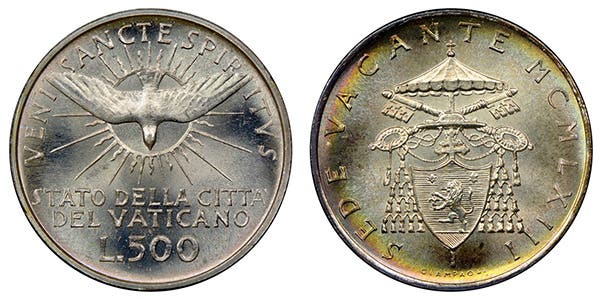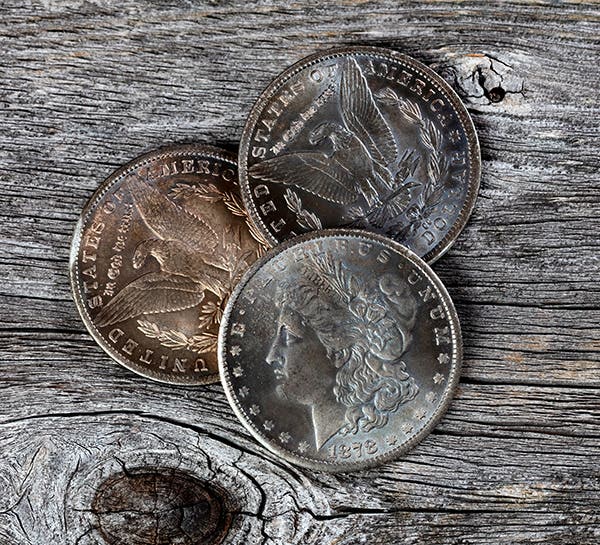Collecting a Set of 20th Century Dollars By Type
These common U.S. coins are inexpensive, easy to assemble and make an interesting type-set collection to have.
There are about as many different ways to collect coins as there are collectors. Often, the method employed by a new collector is to pick a series, often Lincoln cents, and then try to acquire at least one of each date/mintmark combination. This is not a bad approach if you're collecting Lincoln cents, as there are only a few such combinations that are problematic in terms of cost. These are the series keys: 1909-S, 1909-S VDB, 1914-D, and 1931-S.
With 19th century U.S. coins, cost becomes more of a factor, as many pieces in a series are likely to be both scarce and pricy. If the collector focuses on early half dollars, for example, he or she will find that the number of rarities makes set completion difficult or impossible, depending on the collector's budget.
Another approach often taken to avoid the rarities is to collect by design type. That is, instead of trying to get each example of a particular type, the collector purchases one coin to illustrate the type, typically the least expensive coin in the series. Of course, because it is the most common date, the collector may strive for the best example she or he can afford.
But what about a type set featuring coins that are almost all common and inexpensive? What about a type set of 20th century dollars? What would that look like?
1. 20th Century Morgan Dollar, 1901-O
With a mintage of more than 13 million, this George T. Morgan-designed dollar shouldn't be an expensive coin, and it's not. About the date, David Bowers wrote in A Guide Book of Morgan Silver Dollars, "Dollars of 1901-O were released in immense quantities in the early 1960s, and because of this you will have ample opportunity to choose." And it will pay you to choose wisely, as Bowers noted that most of the examples tend to have lots of bagmarks and weak strikes.
The price of the 1901-O is not likely to be a hindrance, although you might have to pay more for a decent coin. According to Bowers' book, values in circulated grades run in a narrow range starting with $28 in VG8 to $39 in AU50. Prices don't jump all that much in lower mint state grades, with an MS64 still well below $100 at $75. The 1901-O lists for only $150 in MS65.
Note that other dates, such as 1904 and 1904-O, are reasonable alternatives. Because the hubs for the Morgan dollars had been destroyed in 1910, new ones had to be created. The result was that most people found the recreated design less pleasing than the original.
2. 1921 Peace Dollar
With its high-relief design by Anthony de Francisci, the 1921 Peace dollar is really a one-year type coin, as the remainder of the series was minted in low relief. In addition, it's considered one of the key dates in the series, both because of its demand for type and its relatively low mintage (1,006,473).
According to Numismatic News "Coin Market" (CM), values for the date start at $65 for a G4 on their way to $1,750 in MS65. If you can afford only a circulated specimen, your best bet would be an AU50 valued at $150. In terms of mint state examples, your best option appears to be the MS63 grade, with a listed value of $490. The value jumps to $1,250 in MS64.
3. Low-Relief Peace Dollar
For this type coin, most any of the high-mintage dates would do. What I would do is look for a date with a relatively low mintage that is still reasonably priced in less than gem condition. For example, consider the 1934, with a mintage of less than a million pieces. CM starts this date at $38. An AU50 lists for just $54, if you're looking for a reasonably nice circulated example. In MS65, it's still just a $660 coin. If this seems too pricy for your type set, you could opt for a 1923, which CM values at $105 in MS65.
4. Copper-Nickel Clad Eisenhower Dollar (1971-1978)
Frank Gasparro designed this large-sized dollar coin, which has the bust of Dwight David Eisenhower (Ike) on the obverse and an eagle landing on the moon on the reverse. The copper-nickel versions have outer layers of 75% copper, 25% nickel, with a pure copper core. You can pick virtually any date of these for your type set, as most all were made in substantial quantities. For this reason, CM doesn't even give prices for these in circulated condition, pricing them only in MS63. For the most part, values are less than $10.
5. Silver-Clad Eisenhower Dollars (1971-1974)
With the same design as before, these have the same silver composition as the 40% silver Kennedy halves minted from 1965-1970. Once again, these are relatively plentiful, and most are valued at less than $20 in higher mint state or proof grades. One that's well preserved will make a nice addition to your 20th century type set.
6. 1776-1976 Bicentennial Clad Eisenhower Dollars
If someone offers you a 1975-dated Ike dollar, you'll know it's counterfeit. With Gasparro's design on the obverse and a dual date in honor of the U.S. Bicentennial, more than 200 million of these were produced. The reverse of the dollars was changed to a design by Dennis R. Williams of the Liberty Bell partially eclipsing the moon. Once again, circulated examples are unpriced by CM, as uncirculated or proof coins abound. All have values of $12 or less.
7. 1776-1976 Bicentennial Silver-Clad Eisenhower Dollars
These have the same design as the preceding type, minted on 40% silver planchets. As these coins were made for collectors and as souvenirs for the general public, they were usually well preserved. Because there was less attrition than you would find for coins made for circulation, they are relatively plentiful, with values less than $15. This will be another inexpensive, attractive coin for your set.
8. 1979-1999 Susan B. Anthony Dollar
This is the first of the attempts to make a small-dollar coin that would actually gain acceptance and circulate widely. It failed, as would all the later attempts. The problem, of course, is that people prefer the dollar bill to the coin, no matter what size it is. In the European countries I've visited, the comparable coin does circulate, as there are no paper money equivalents. This is also true for Canada and Mexico.
Both sides of this coin were designed by Mint Chief Engraver Frank Gasparro. The obverse is a depiction of famed women's rights pioneer Susan B. Anthony, whereas the reverse is a reduced-size copy of Gasparro's design for the Eisenhower dollar.
According to the Red Book (A Guide Book of United States Coins), "The size of this coin, its silver color, and its edge reeding caused it to be confused with the quarter, and it failed to gain widespread public acceptance." I can still remember accidentally dropping a coin into a large barrel full of trash outside a restaurant and being relieved that the coin was only a quarter, not one of the Susan B. Anthony dollars I had in my pocket. I never carried them after that.
Although it's standard practice to list this series from 1979-1999, it really consists of a 3-year period from 1979-1981 and then a further production in 1999. The renewed minting was in anticipation of an upsurge of interest in the coin before the Sacagawea dollar appeared in 2000.
For the collector, this is another inexpensive type coin, as most of the date/mintmark combinations list for $20 or less even in MS65. Pick a date you like and buy a nice example of it.
9. 2000 Sacagawea Dollar
Here, we encounter a minor controversy: Is the last year of the 20th century 1999 or 2000? According to something I found online: "The year 2000 is special[,] even though it isn't the start of the 21st century[,] because it is a leap year. A fairly precise correction to the Gregorian calendar debuted in 1582 and stated that a century year will only be a leap year if it is evenly divisible by 400, which is true for Y2K." The arguments I found all concluded that the year 2000 is the end of the 20th century, with 2001 being the beginning of the 21st century. Thus, the 2000 Sacagawea dollar is a must for our 20th century dollar type set.
After a national competition with more than 100 submissions, Glenna Goodacre's depiction of Sacagawea carrying her infant son, Jean Baptiste, on her back was chosen for the dollar's obverse. The eagle in flight reverse design was the work of Mint engraver Thomas D. Rogers, Sr.
Although Sacagawea dollars have a golden finish and a plain edge in order to distinguish them from other circulating coins, it didn't make them more acceptable to the general public. When was the last time you received one in change? Have you ever gotten one in change?
Like the other recent dollar coins I've talked about, finding a 2000 Sacagawea dollar for a reasonable price should be no problem. More than a billion of the 2000 and 2000-D dollars were coined, and CM values them in MS65 at $7.50 and $11, respectively. A 2000-S proof version lists for just $5 in PR65.
That's the end of my list of coins comprising a 20th century type set of U.S. dollars. With the exception of Morgan dollars, the remainder are parts of series fairly easy to collect in their entirety. Still, if you assemble one each of the coins I've discussed here, you'll have an interesting type set of coins that many non-collectors won't recognize. And when you tell them how little it cost to assemble, they may decide to become collectors themselves!








